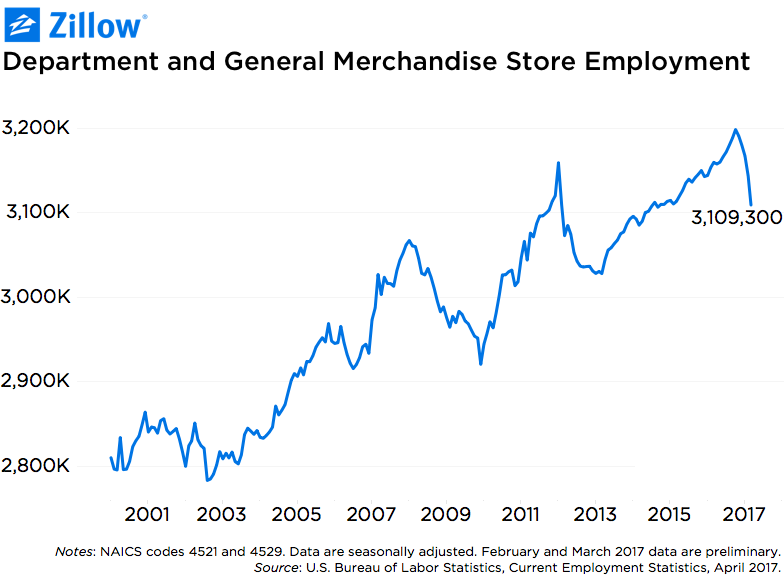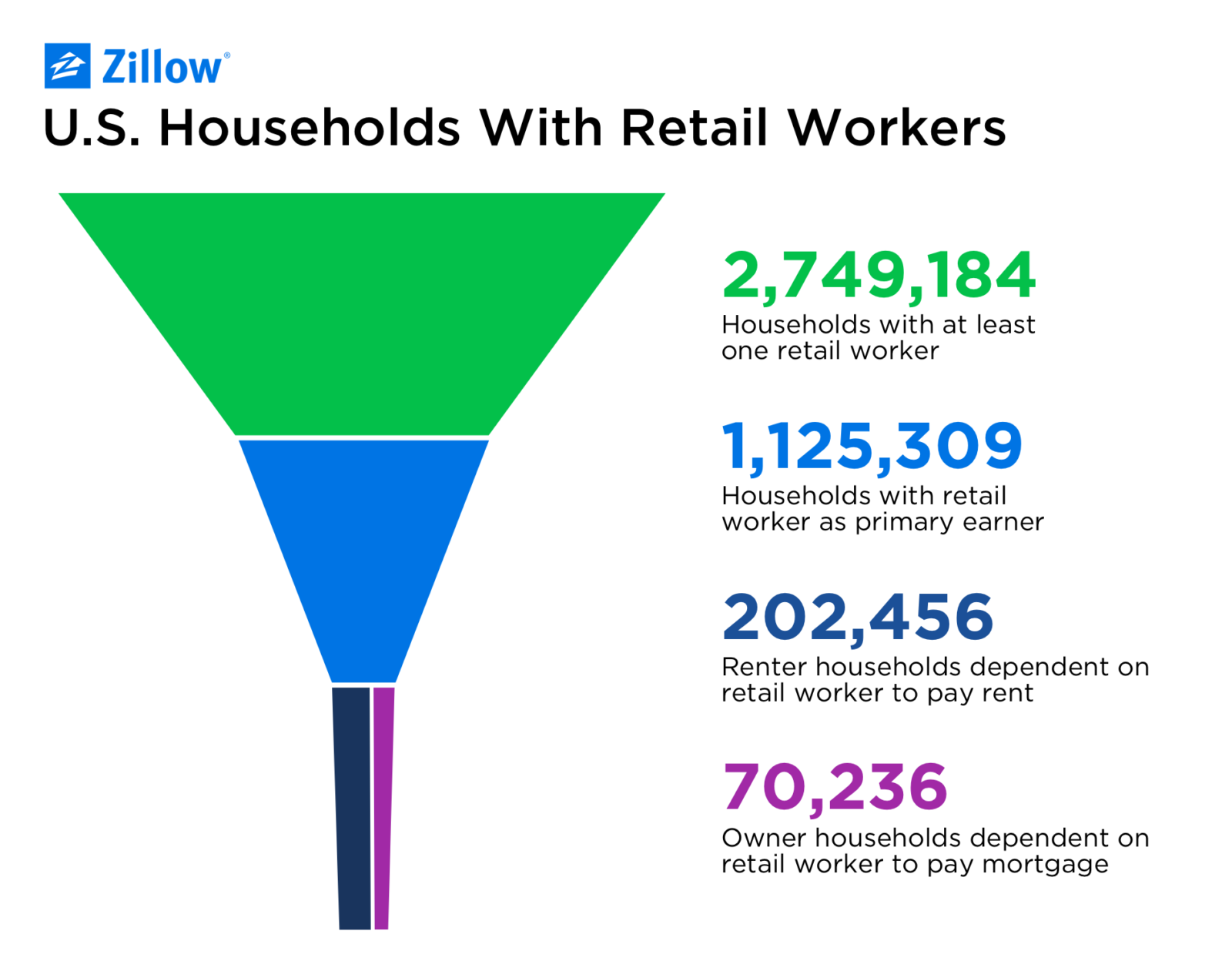zillow.com/research
- Department and general merchandise store employment dropped sharply during the first quarter of 2017.
- Almost 300,000 American households are dependent on the income from a retail job to cover monthly housing costs.
- Fayetteville, Ark., Dallas-Fort Worth and Indianapolis are the housing markets most at risk from declining department and general merchandise store jobs.
American retail workers had a rough start to 2017, with department stores and general retail shops shedding tens of thousands of jobs in Q1. And continued losses could imperil hundreds of thousands of households that depend on the income from a retail worker to pay the rent or mortgage each month.
 In the first three months of 2017, the number of jobs in department and general merchandise stores fell by 2.3 percent from the quarter prior, or 71,000 jobs, to 3.11 million – essentially erasing two years of growth in the sector, according to preliminary data from the U.S. Bureau of Labor Statistics.[1] The quarterly decline was the biggest such 3-month drop since early 2012.[2]
In the first three months of 2017, the number of jobs in department and general merchandise stores fell by 2.3 percent from the quarter prior, or 71,000 jobs, to 3.11 million – essentially erasing two years of growth in the sector, according to preliminary data from the U.S. Bureau of Labor Statistics.[1] The quarterly decline was the biggest such 3-month drop since early 2012.[2]Retail Jobs Pay the Rent
Retail jobs, while declining, remain a critical part of the American jobs landscape. About 2.7 million U.S. households (2.3 percent) include one member who works in a department or general merchandise store. At the median, these workers account for 41 percent of their household’s total income.[3]
And in 1.1 million households nationwide (0.9 percent of all U.S. households, and 41 percent of the 2.7 million households home to at least one retail worker), the retail worker is the highest earner in the household. Typically in these households, the primary earner’s income accounts for about two-thirds of the household’s total income (according to the most recent data available from the American Community Survey).
A small majority (53 percent) of households in which a retail worker is the primary earner are homeowners, and 20 percent of these own their home outright (with the remaining 33 percent holding a mortgage). The remaining 47 percent (1.1 million) rent. Almost a quarter (24 percent, or 273,000) of these retail-worker-headed households fully depend on the retail worker’s income to cover monthly housing costs, unable to pay the mortgage or rent if the retail worker lost their job. A large majority of these households dependent on the income from a retail job are renters: 74 percent rent, and 26 percent own (with a mortgage).
Markets with the largest shares of households dependent upon a retail job to cover housing costs include:[4]
- Fayetteville, Ark.: About 3,800 households, or 2.1 percent of all households;[5]
- Dallas-Fort Worth: About 11,300 households, or 0.5 percent of all households;
- Indianapolis: About 3,200 households, or 0.4 percent of all households;
- Minneapolis-St. Paul: About 5,700 households, or 0.4 percent of all households;
- Kansas City, Mo.: About 3,300 households, or 0.4 percent of all households.
In all five of these markets, the majority of households dependent on retail income are renter households – ranging from 55 percent in Minneapolis-St. Paul, to 88 percent in Kansas City.
In general, the housing market in most of these areas has been strong in recent years. The median home value in Minneapolis-St. Paul surpassed its pre-crisis peak for the first time in March – in other words, homes in the Twin Cities area are more valuable than they’ve ever been. Similarly, the median home value in Dallas-Fort Worth is 37 percent above its pre-crisis peak; in Fayetteville, the median home value is 8 percent above its pre-crisis peak (home values in Indianapolis and Kansas City are still, on average, about 2 percent below their pre-crisis peaks).
It’s important to keep this data in perspective: Generally speaking, the number of households vulnerable to retail job losses is relatively small, and labor markets in even the most vulnerable communities are sufficiently diversified that some job losses should not spill over broadly into the housing market.
However, a not-insignificant number of families are likely to feel a pinch on the individual and household level if retail job losses continue.
Related:
- Close to Home: Why Stay-at-Home Parenting is Increasingly a Luxury
- Dismal Growth in Coal Country Home Values
- Occupation, Location & Preference: Why an Affordable Home to Me may not be Affordable to You
[1] NAICS codes 4521 and 4529. Data from the Bureau of Labor Statistics, Current Employment Statistics, preliminary April 2017 data.
[2] Between January 2012 and March 2013, department and general store employment fell by 4.3 percent, comparable to the 4.8 percent drop in employment reported from February 2008 to December 2009 during the depth of the recession.
[3] Includes industry codes 5380 (Department Stores and Discount Stores) and 5390 (Miscellaneous General Merchandise Stores). Data from the U.S. Census Bureau, American Community Survey, 2015 made available by the University of Minnesota, IPUMS-USA.
[4] Those for which we have sufficient data to assess household dependence on department and general merchandise store jobs.
[5] The very large share of retail-worker-dependent households in the Fayetteville metro is very likely attributable to the presence of retail giant Walmart’s global headquarters in nearby Bentonville, Ark. While many corporate Walmart employees may not hold traditional retail positions, weakness in Walmart stores themselves can be reflected in corporate layoffs, and so we kept this market in this analysis.


No comments:
Post a Comment